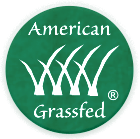
Cows were meant to eat grass. Period. The industrialization of farms into factories has led to mass production of unhealthy cows being pumped with hormones and antibiotics and fed grains including GMO corn and soy.
Organic beef is healthier because the cows are not given hormones or antibiotics, but they are still most likely fed grains, albeit non-GMO, which is great. Unless the meat has a grass-fed label, you can assume it was fed grain. More on labeling below.
From a nutritional standpoint, studies have shown that grass-fed beef is naturally leaner with a different fatty acid profile than grain-fed beef. It also contains higher amounts of the following essential nutrients.
What Are The Benefits of Grass-Fed Beef?
Omega 3’s – Omega 3 fatty acids have more of an anti-inflammatory effect whereas omega 6’s have more of an inflammatory effect on the body. Ideally, you want a diet that contains a ratio of around 3:1 omega 6 to omega 3, respectively. Grass-fed beef has a ratio averaging 1.5:1 compared to grain fed beef, which averages 7.65:1. [1]
Conjugated Linoleic Acid (CLA) – CLA is an important polyunsaturated fatty acid that has many health benefits, which include reducing body fat and cardiovascular disease, anticancer properties, modulating the immune and inflammatory response, as well as improving bone mass. Grass-fed beef has been found to have 2 to 3 times more CLA than grain fed beef. [1,2]
Beta Carotene – Beta-carotene is a precursor to retinol (vitamin A), which is crucial for normal vision, the integrity of the skin providing a protective barrier to bacterial and viral infections, bone health, and immune function. Grass-fed beef contains as much as 7 times the amount of beta-carotene that grain-fed beef does. [1]
Antioxidants – Antioxidants such as vitamin E, glutathione, and superoxide dismutase protect cells from the effects of free radicals and DNA damage. Studies have found grass fed beef to be significantly higher in these antioxidants. [1]
Grass Fed Labeling – What you need to know
The USDA recently decided that they would no longer define the criteria for what qualifies as “grass-fed” for labeling purposes. However, they are still regulating the labeling process. Sound confusing? It’s actually quite simple. Producers will now be able to determine their own defined standard, which could be completely different from another producers. It will be up to the producer to submit to the USDA an explanation of what they define as grass-fed for their operation and then provide documentation to support it.
According to the USDA, a label that simply says, “grass-fed” should be 100% grass-fed. Otherwise, it will state the percentage such as “50% grass fed, 50% grain fed”. The problem is that the USDA will not be enforcing any sort of verification that this documentation is accurate other than investigating claims that they believe may not be truthful, as those situations should arise. There will most likely be limited resources allocated to these investigations.


 The good news is that there are currently three private organizations that have a certification process for grass-fed beef. Look for the labels American Grassfed, Food Alliance, or Animal Welfare Approved.
The good news is that there are currently three private organizations that have a certification process for grass-fed beef. Look for the labels American Grassfed, Food Alliance, or Animal Welfare Approved.
Where to buy Grass-Fed Meat
Buying grass-fed meat from local farms is always best because you can verify their farming practices first hand. You can also find good quality grass-fed meats at Whole Foods and other local natural grocery stores who often purchase from local farms or other trusted sources. In the Seattle area, I highly recommend PCC Natural Markets. Farmers Markets are also a great place to look for good quality meats from local farms.
I also recommend checking out Local Harvest, which is a great resource for finding local farms in your area where you can buy grass-fed meat, pasture raised poultry, pork, and eggs, as well as organic produce.
Eat Wild is another resource with a list of farms in each state that sell grass-fed meat, poultry, etc.
If you do not live nearby a natural grocery store or farmers markets then there are some great online stores that you can purchase high-quality meats from such as U.S. Wellness Meats.
1. Daley CA, Abbott A, Doyle PS, Nader GA, Larson S. A review of fatty acid profiles and antioxidant content in grass-fed and grain-fed beef. Nutrition journal. 2010 Mar 10;9(1):1.
2. Dilzer A, Park Y. Implication of conjugated linoleic acid (CLA) in human health. Critical reviews in food science and nutrition. 2012 Jun 1;52(6):488-513.

